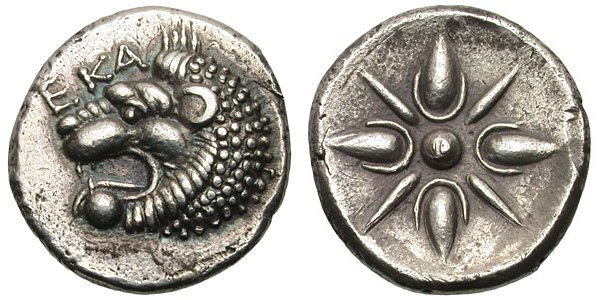Halicarnassus (Hecatomnus), silver, tetrobols (392-377 BCE)
From SILVER
392 BCE - 377 BCE Silver 5,830 kg
Description
| ObverseInscription or printing placed on the obverse.: | EKA (Greek).Head of lion facing to left, mouth open, EKA above. |
| ReverseInscription or printing placed on the reverse.: | Star-like floral pattern. |
Mint and issuing power
| MintIdentifies the place of manufacture or issue of a numismatic object.: | Halicarnassus | Ancient regionAncient region.: | Caria | Modern countryModern country: Turkey | AuthorityIdentifies the issuing power. The authority can be "pretended" when the name or the portrait of X is on the coin but he/she was not the issuing power. It can also be "uncertain" when there is no mention of X on the coin but he/she was the issuing power according to the historical sources: | Hecatomnus of Caria (satrap of Caria, c. 395-c. 377 BC), Persian Empire |
Chronology
| FromIdentifies the initial date in a range assigned in a numismatic context. | 392 BCE | toIdentifies the final date in a range assigned in a numismatic context.. | 377 BCE | PeriodTime period of the numismatic object.: Classical 480-323 BC |
Physical description
| MetalThe physical material (usually metal) from which an object is made.: | Silver |
Median weightMedian of the weights of numismatic objects (in grams). in grams | 4.20 | DenominationTerm indicating the value of a numismatic object. Examples: tetradrachm, chalkous, denarius.: | tetrobol or trite | StandardStandard.: | Milesian |
Image

AC245 Hecatomnus.jpeg [1]
References
| Die study referencePublication of the study: | Konuk 1998b1Konuk 1998b | ||
| Coin series referenceReference to coin series study: | Sear II2Sear II, n° 4951, RQEMAC3RQEMAC, n° 245 | ||
| Coin series web referenceCoin series web references: | |||
Obverse dies distribution
| FrequencyFrequency of specimen in distribution. ᵖ | Number of obversesNumber of obverse dies. ᵖ (o) | % (o) | Number of coinsNumber of coins. (n) | % (n) | Die nameName(s) of the die(s). |
| 1 | 20 | 38.46 | 20 | 14.18 | III, 1, 2, 3, 4, 5, 6, 11, 13, 18, 21, 24, 25, 27, 34, 38, 40, 41, 42, 43 |
| 2 | 11 | 21.15 | 22 | 15.6 | VII, VIII, 8, 9, 10, 14, 15, 16, 19, 23, 44 |
| 3 | 7 | 13.46 | 21 | 14.89 | IV, 7, 20, 26, 32, 33, 39 |
| 4 | 4 | 7.69 | 16 | 11.35 | VI, 12, 22, 31 |
| 5 | 5 | 9.62 | 25 | 17.73 | V, 17, 28, 35, 37 |
| 6 | 3 | 5.77 | 18 | 12.77 | I, II, 30 |
| 8 | 1 | 1.92 | 8 | 5.67 | 29 |
| 11 | 1 | 1.92 | 11 | 7.8 | 36 |
| Total | 52 of 52 | 99.99 | 141 of 141 | 99.99 |
Reverse dies distribution
no distribution is available
Quantification
| Number of obversesNumber of obverse dies. ᵖ (o) | 52 | Number of singletons (o1)The number of singleton coins. ᵖ | 20 |
| Number of reverse diesNumber of reverse dies. (r) | 102 | Number of coinsNumber of coins. (n) | 141 |
| Coins per obverse dieNumber of coins per obverse die. (n/o) | 2.71 | Coins per reverse dieNumber of coins per reverse die. (n/r) | 1.38 |
| Reverse per obverse ratioRatio of obverse dies divided by reverse dies. (r/o) | 1.96 | Percentage of singletons (o1)number of coins (n) divided by the number of singletons (o1) ᵖ | 38.46 % |
| Original number of dies (O) (Carter 1983 formula)The estimation of the number of coins according to Carter 1983 ᵖ | 69.4 | Coins struck if 20,000 as average productivity per dieCoins made if the average productivity for obverses (according to Carter) is 20,000. ᵖ | 1,388,000 |
| Original number of dies (O) (Esty 2011 formula)The estimation of the number of coins according to the singleton formula in Esty 2011 ᵖ (O) | 82.38 | Survival rate if 20,000 as average productivity per dieSurvival rate if average productivity is 20,000. ᵖ | 0.00010 |
| Coverage (o = % of O) (Esty 1984 formula)Esty 1984 - coverage (% of O) ᵖ (o = % of O) | 85.82% | Die productivity if survival rate 1/2,000Average productivity if survival rate is 1/2,000. ᵖ | 4,063.4 |
| Weight of silver (in kg) if 20,000 coins per die (O = Carter formula)Carter 1983 * Median weight * 20000 (*10 if gold or electrum) ᵖ | 5,830 kg <br /> 5,830 kg | Die productivity if survival rate 1/5,000Average productivity if survival rate is 1/5,000. ᵖ | 10,158.5 |
Remarks
Likely military